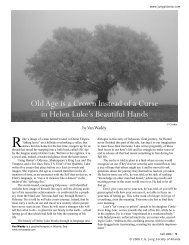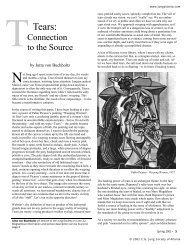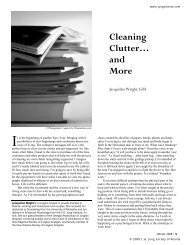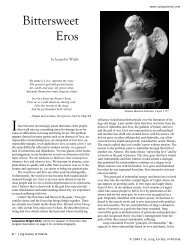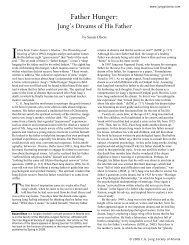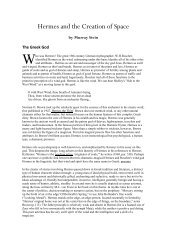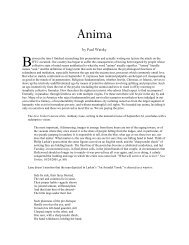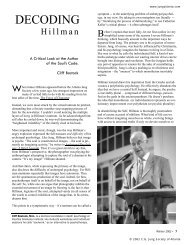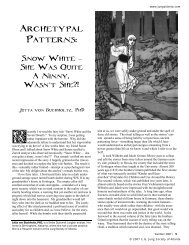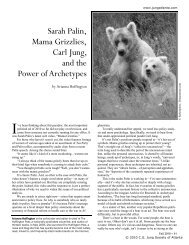The Grail Legend - C.G. Jung Society of Atlanta
The Grail Legend - C.G. Jung Society of Atlanta
The Grail Legend - C.G. Jung Society of Atlanta
Create successful ePaper yourself
Turn your PDF publications into a flip-book with our unique Google optimized e-Paper software.
arl <strong>Jung</strong> remained faithful to his wife Emma in one<br />
C<br />
way only serious scholars can understand: He<br />
promised never to talk or write about the <strong>Grail</strong><br />
<strong>Legend</strong>, as Emma <strong>Jung</strong> spent thirty years <strong>of</strong> her life<br />
researching the <strong>Grail</strong> story. She died in 1955 before she could<br />
finish and publish her work. In keeping with his promise to her,<br />
<strong>Jung</strong> asked Marie-Louise von Franz to complete his wife’s<br />
lifelong endeavor. <strong>The</strong> <strong>Grail</strong> <strong>Legend</strong>, by Emma <strong>Jung</strong> and<br />
Marie-Louise von Franz, is the result <strong>of</strong> this joint feminine<br />
circumambulation around the archetype <strong>of</strong> the Self.<br />
<strong>The</strong>irs is a psychological consideration <strong>of</strong> the <strong>Grail</strong> legend<br />
based on meticulous research – with countless multi-layered<br />
side-bars interwoven like an iridescent thread – reaching as far<br />
back as Celtic and pre-Christian Eastern sources around the<br />
eighth or ninth century, focusing mainly on two main texts from<br />
the twelfth century, the work <strong>of</strong> Chretein de Troyes and <strong>of</strong><br />
Robert de Boron.<br />
<strong>The</strong> semi-historical, semi-legendary King Arthur and his<br />
knights <strong>of</strong> the Roundtable form the back drop <strong>of</strong> this story <strong>of</strong><br />
12 • <strong>Jung</strong> <strong>Society</strong> <strong>of</strong> <strong>Atlanta</strong><br />
<strong>The</strong> <strong>Grail</strong> <strong>Legend</strong><br />
by Emma <strong>Jung</strong> and Marie-Louise von Franz<br />
report by Van Waddy<br />
www.jungatlanta.com<br />
Perceval’s quest for and encounter with the <strong>Grail</strong>. Arthur is<br />
traced back to sources dating from the fifth or sixth century<br />
when Britain endured the Saxon invasion, but it is Chretein’s<br />
and Boron’s inclusion <strong>of</strong> Arthur and his knights in connection<br />
with the <strong>Grail</strong> that embody, for Emma <strong>Jung</strong>, “the psychological<br />
expression <strong>of</strong> an extraordinary stirring <strong>of</strong> the unconscious” at<br />
that time, transforming “the popular fairy tale <strong>of</strong> a simpleton<br />
into a mystical religious quest” that inevitably “addresses the<br />
religious problem <strong>of</strong> modern man.”<br />
It would be impossible, within the scope <strong>of</strong> this report, to<br />
do homage to these women’s 400 pages <strong>of</strong> conscientious research<br />
and insight. Each motif, each connecting story within the<br />
story, each invitation to deeper reflection defies my ability to<br />
contain its completeness. I can only share the thrill <strong>of</strong> my own<br />
experience <strong>of</strong> how the <strong>Grail</strong> legend captures my personal imagination.<br />
<strong>The</strong> story is fairytale material. <strong>The</strong> <strong>Grail</strong>—a mysterious,<br />
Van Waddy is a family and couples therapist with a practice in<br />
<strong>Atlanta</strong>.<br />
© 2006 C.G. <strong>Jung</strong> <strong>Society</strong> <strong>of</strong> <strong>Atlanta</strong>
life-preserving and sustenance-dispensing vessel—is guarded<br />
by a king in a castle that is “difficult to find.” <strong>The</strong> king is either<br />
old or suffering (different versions <strong>of</strong> the same story) from<br />
some mysterious wound and his kingdom is devastated. <strong>The</strong><br />
king can only be restored to health if a knight <strong>of</strong> conspicuous<br />
excellence finds the castle and, seeing what goes on there, asks<br />
a certain question. Perceval thinks himself up to the task and<br />
sets out on the quest. He fails to ask the question “about the<br />
origin <strong>of</strong> evil, the king’s wound, and about the <strong>Grail</strong>’s meaning”<br />
the first time he encounters the <strong>Grail</strong> Castle and the <strong>Grail</strong>.<br />
As in all fairy tales and myths, there is a second chance. Perceval<br />
prevails.<br />
<strong>The</strong> <strong>Grail</strong> Castle, “the castle difficult to find,” is the timeless<br />
dimension, concealed from view – for our authors, an<br />
archetypal concept <strong>of</strong> the unconscious. <strong>The</strong> <strong>Grail</strong>, available<br />
only to one worthy to share in what it <strong>of</strong>fers, is thought by some<br />
to be the vessel which held the Christ’s blood (his essence, his<br />
soul substance), hidden by Joseph <strong>of</strong> Arimathea after the<br />
Christ’s death. This vessel, for <strong>Jung</strong>, “signifies the whole psychic<br />
man as a realization <strong>of</strong> divinity reaching right down into<br />
matter”. She identifies this, in <strong>Jung</strong>ian terms, as the Self—that<br />
inner guide that is God’s voice, “the hidden disposition to<br />
wholeness which slumbers in the depths <strong>of</strong> the unconscious <strong>of</strong><br />
each person.” <strong>The</strong> <strong>Grail</strong> story is itself a projection <strong>of</strong> the Self as<br />
an inner center, unrealized by and inaccessible to those trapped<br />
in the medieval mindset.<br />
“<strong>The</strong> story <strong>of</strong> Perceval anticipates psychic problems reaching<br />
so far into the future that it could not be wholly comprehended<br />
by the medieval attitude.” <strong>The</strong> medieval world, represented<br />
by the ailing king in our story, suffered from a “onesided<br />
insistence on the light side <strong>of</strong> the God image (in the<br />
Christ figure) and so cast <strong>of</strong>f its shadow – the Anti-Christ, its<br />
individual inner opposite – outwardly onto barbarian opponents<br />
instead <strong>of</strong> being able to integrate it.”<br />
Arthur’s knights led a life <strong>of</strong> “high virtue” which led to<br />
pride and was perverted into evil. <strong>The</strong>re was a “too intense,<br />
one-sided spirituality <strong>of</strong> the feminine found in the Cult <strong>of</strong> the<br />
Virgin,” without a balanced genuine relationship with the actual<br />
women in their personal lives. “<strong>The</strong>re was a drifting apart <strong>of</strong> the<br />
opposites <strong>of</strong> spirit and world, <strong>of</strong> spiritual matters and worldly<br />
matters, choosing holiness instead <strong>of</strong> humanity.”<br />
This problem <strong>of</strong> opposites and the failure to recognize and<br />
integrate the shadow were responsible for the king’s sickness<br />
(the king representing the dominant collective consciousness).<br />
<strong>The</strong> old king had to die, or the ailing king had to be restored,<br />
redeemed, before the land could be freed from its present state.<br />
“It is as if the dark aspect <strong>of</strong> divinity had attacked him in order<br />
to awaken him to a more conscious religious attitude.” Until he<br />
grappled with the dark divinity—like Jacob and Job before<br />
him—he could not come to a realization <strong>of</strong> the totality <strong>of</strong> the<br />
God-image.<br />
he <strong>Grail</strong> “signifies a stage <strong>of</strong> development <strong>of</strong> the<br />
T<br />
human spirit, when man is no longer satisfied with<br />
the materialistic view or with the effectiveness <strong>of</strong><br />
working things, but goes beyond this and endows<br />
the concrete with a symbolic meaning.” This requires the ability<br />
to reflect, to discern, to place value. In this respect, the <strong>Grail</strong><br />
can be compared to the Feeling Function, our ability to discriminate<br />
between good and evil that reaches beyond the<br />
world’s perspective <strong>of</strong> these. It means rediscovering the soul <strong>of</strong><br />
www.jungatlanta.com<br />
nature, the incarnate God.<br />
It would be misleading not to mention that Perceval went<br />
on many a misguided adventure, lost many battles, made wrong<br />
turns in the woods, and, certainly, didn’t ask the question –<br />
suffered from his own wounded Feeling Function – when he<br />
had the chance. All <strong>of</strong> these adventures are explored and given<br />
their true place. <strong>The</strong> journey is not a straight line. We all know<br />
about that.<br />
<strong>The</strong> <strong>Grail</strong>, says <strong>Jung</strong>, is the principle <strong>of</strong> individuation<br />
available within each person. “As threads <strong>of</strong> fabric are woven<br />
into a pattern, so the Self as a living garment <strong>of</strong> divinity is<br />
woven out <strong>of</strong> the many decisions and crises, in themselves<br />
possibly insignificant, by which we are affected in the course <strong>of</strong><br />
our lives.” Individuation comes one person at a time, not to the<br />
collective, “for only in the individual are opposites reconciled<br />
and united.” I take from this that I, personally, cannot wait for<br />
the collective to come to an awareness <strong>of</strong> what is important to<br />
heal our earth, to come to consciousness, to discover the truth<br />
behind the illusions we worship.<br />
Perceval’s quest, spiral though it was, was that <strong>of</strong><br />
“redeeming the Spirit <strong>of</strong> God in matter, under the guidance <strong>of</strong><br />
the Self, the ‘inner Christ’ . . . . to discover the form in which<br />
the essential psychic life <strong>of</strong> Christ continues to exist and what<br />
that means.” This <strong>Grail</strong> is concerned with “carrying on Christ’s<br />
effectiveness in this world,” as a vessel through which the<br />
divine can have its way.<br />
But Perceval had to ask the question, discern the value and<br />
importance <strong>of</strong> what he saw around him. “To whom is the <strong>Grail</strong><br />
brought?” and “Whom does the <strong>Grail</strong> serve?” seem to be the<br />
archetypal tipping point <strong>of</strong> the story. <strong>The</strong> <strong>Grail</strong> is brought to<br />
the Old <strong>Grail</strong> King; the goal <strong>of</strong> the quest is death to the old king<br />
(not just finding the <strong>Grail</strong>) – death to the dominant collective<br />
consciousness <strong>of</strong> the day and to the one-sided god image it<br />
maintains. With the secret words spoken and Perceval’s royal<br />
ancestry revealed, the <strong>Grail</strong> is placed in his care. In the story’s<br />
version with the ailing King, the ailing King, along with his<br />
kingdom, is temporarily restored.<br />
ung points out that Perceval didn’t himself com-<br />
J<br />
plete the arch. He remained at the <strong>Grail</strong> Castle and<br />
did not choose to take the <strong>Grail</strong> back to Arthur’s<br />
court. Is not the hero supposed to return with the<br />
boon? Because <strong>of</strong> this, the <strong>Grail</strong> disappeared with his death,<br />
went back into concealment. For our authors, this means that<br />
the archetypal <strong>Grail</strong> remains in the unconscious <strong>of</strong> each living<br />
person, available as an inner guide, the voice <strong>of</strong> the divine,<br />
inviting each <strong>of</strong> us to our individual completeness.<br />
“Individuation, when seen from the ‘other’ (archetypal) side<br />
actually depicts the process <strong>of</strong> the incarnation <strong>of</strong> the divine.”<br />
To ask the question, “Whom does the <strong>Grail</strong> serve?” is to<br />
ask, perhaps, Whom does the Self serve? Does the Self serve<br />
that ultimate Wholeness <strong>of</strong> which we each participate? Does the<br />
Self come in the service <strong>of</strong> that numinous experience we each<br />
encounter once or twice in a lifetime that feeds our hunger for<br />
deeper connection with life? Is the Self available to continue<br />
the incarnation <strong>of</strong> the divine in whatever form it happens to be<br />
evolving in the universe?<br />
Encountering the <strong>Grail</strong> imposes a question on the beholder,<br />
say our authors, it does not impart direct knowledge. <strong>The</strong> <strong>Grail</strong><br />
“gives us an emotional readiness to receive,” a numinous experience<br />
<strong>of</strong> our inner center, the Self. I remember Carl <strong>Jung</strong>, in<br />
Winter 2006 • 13<br />
© 2006 C.G. <strong>Jung</strong> <strong>Society</strong> <strong>of</strong> <strong>Atlanta</strong>
Memories Dreams, Reflections, speaking <strong>of</strong> life addressing a<br />
question to him: “Or, conversely, I myself am a question which<br />
is addressed to the world, and I must communicate my answer;<br />
otherwise I am dependent on the world’s answer.” <strong>The</strong> Self<br />
asks a question <strong>of</strong> us unique to our personal destiny or daimon.<br />
Our authors use the characters <strong>of</strong> Perceval and Gauvain to<br />
urge us to listen to our own inner nature and not to be distracted<br />
by what the world thinks we ought to be doing. Perceval, the<br />
Introvert, gets dazzled and distracted from his mission by<br />
Arthur’s court and the colorful knights: “An unreflective Perceval<br />
(not asking the question, not accessing his Introverted<br />
Feeling Function) is a Perceval cut <strong>of</strong>f from the true source <strong>of</strong><br />
his inner being.” His extroverted activity, without reflection on<br />
the true value <strong>of</strong> what he experienced, drains and weakens him.<br />
Gauvain, the great Christian hero and Extrovert, fights<br />
unreflectively in the story for what is recognized by the community<br />
to be right. He falls asleep when the time comes for him<br />
to use his Feeling Function, reflect on what is happening around<br />
him. Eventually, Perceval “hangs back, seeks the ‘lost God’ and<br />
his own soul,” gets back in touch with his Introverted Feeling<br />
Function and can ask the question. I, too, get out <strong>of</strong> sorts when<br />
I do not make time for my inner life, if I am too danced around<br />
by the colorful extroversion <strong>of</strong> the outer world. <strong>Jung</strong> and von<br />
Franz make the distinction between “the uninterrupted chain <strong>of</strong><br />
outer events versus making time to reflect on one’s experiences”<br />
as vital for both introverts and extroverts in the process<br />
<strong>of</strong> individuation.<br />
I<br />
have only scratched the surface here <strong>of</strong> Emma <strong>Jung</strong>’s life<br />
endeavor and Marie-Louise von Franz’ generous contribution<br />
to <strong>Jung</strong>ian thought. <strong>The</strong>ir book has an entire exploration<br />
<strong>of</strong> the doctrine <strong>of</strong> the Trinity and their transformation <strong>of</strong> it<br />
into a quaternity – Father, Son, Holy Spirit, and Mary (<strong>The</strong><br />
<strong>Grail</strong>) and the Feminine Feeling Function. <strong>The</strong>y introduce a<br />
section on Merlin as the image <strong>of</strong> the whole man, as the one<br />
who points to the unconscious and past it to the wholeness<br />
beyond opposites. It is beyond the scope <strong>of</strong> this paper to include<br />
14 • <strong>Jung</strong> <strong>Society</strong> <strong>of</strong> <strong>Atlanta</strong><br />
Poetry by Jack Hayes<br />
BLACKBERRY PRAYER<br />
God, grant me your prolific root,<br />
that I may spread the good by branching.<br />
Let me poke up through the sidewalks,<br />
under fences, in the wasted places<br />
and <strong>of</strong> course in flower gardens<br />
side-by-side the daffodil and dahlia.<br />
Let me intermarry like the Irish<br />
and the German, Jew and Christian,<br />
like the African and Cuban.<br />
www.jungatlanta.com<br />
these important explorations.<br />
I was moved to incorporate metaphors to reframe so-called<br />
Christian ones. I love thinking <strong>of</strong> the Self as rich in second<br />
chances (Perceval gets that second chance, as we all do, over<br />
and over). I am moved to more trust in the incarnating power <strong>of</strong><br />
the Self in each <strong>of</strong> us as a purposeful movement <strong>of</strong> the divine in<br />
our midst. I wander around our authors’ notion that the origin<br />
<strong>of</strong> evil (the shadow) and the dark side <strong>of</strong> God are questions still<br />
to be solved by post-modern man.<br />
I was pulled to read this work because <strong>of</strong> Robert Johnson’s<br />
love affair with Perceval and the <strong>Grail</strong> <strong>Legend</strong> that dates from<br />
around 1987 when he first began talking about it as his platform<br />
for exploring Western Man’s Wounded Feeling Function.<br />
Emma <strong>Jung</strong> was his analyst in Zurich and he took a course on<br />
the <strong>Grail</strong> <strong>Legend</strong> from her. I am indebted to Robert for pointing<br />
the way and indebted to Emma <strong>Jung</strong> for her passionate search<br />
that reaches beyond the grave. I am also moved by Carl <strong>Jung</strong>’s<br />
fidelity to his wife in the one way he could truly honor her.<br />
I am grateful, too, for your fidelity in wandering with me<br />
through this lengthy report ■<br />
Teach me, teach me ways <strong>of</strong> blossoming<br />
that I may be resplendent<br />
though my legs are little more than canes<br />
and cannot stand for long.<br />
I ask you, let me reach with sweetness,<br />
let me <strong>of</strong>fer up my treasure,<br />
let me serve myself to hungry passersby.<br />
Yes, let the birds, let even turtles taste <strong>of</strong> me,<br />
for I am all I am and nothing more.<br />
Yet I am nothing, nothing less than wonderful.<br />
Jack Hayes is a poet and a journalist for more than three decades.<br />
A collection <strong>of</strong> his poems won the 1992 Georgia Poetry<br />
Circuit award and in 1993, he was a recipient <strong>of</strong> the Rainmaker<br />
Award. Jack recently became Georgia's first Certified<br />
Poetry <strong>The</strong>rapist. He is currently completing an MSW internship<br />
with placements at Dekalb Addiction Clinic and a pilot<br />
program at the Rockdale County Juvenile Court system.<br />
© 2006 C.G. <strong>Jung</strong> <strong>Society</strong> <strong>of</strong> <strong>Atlanta</strong>



